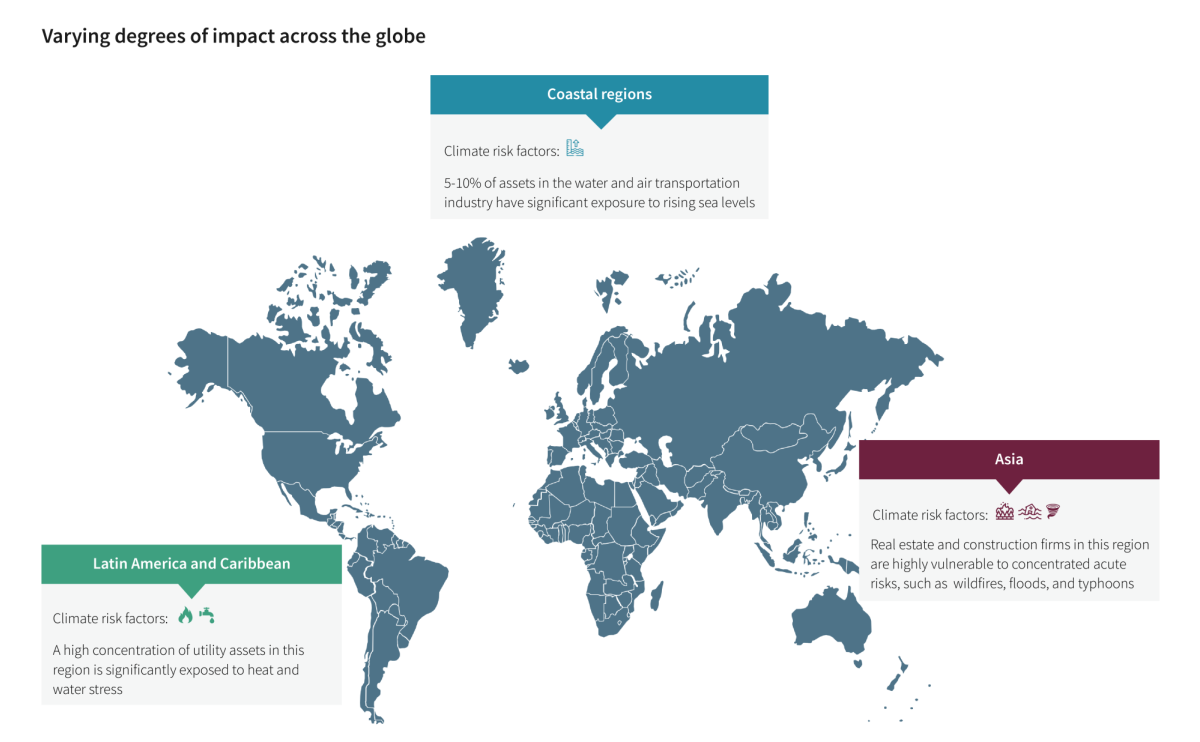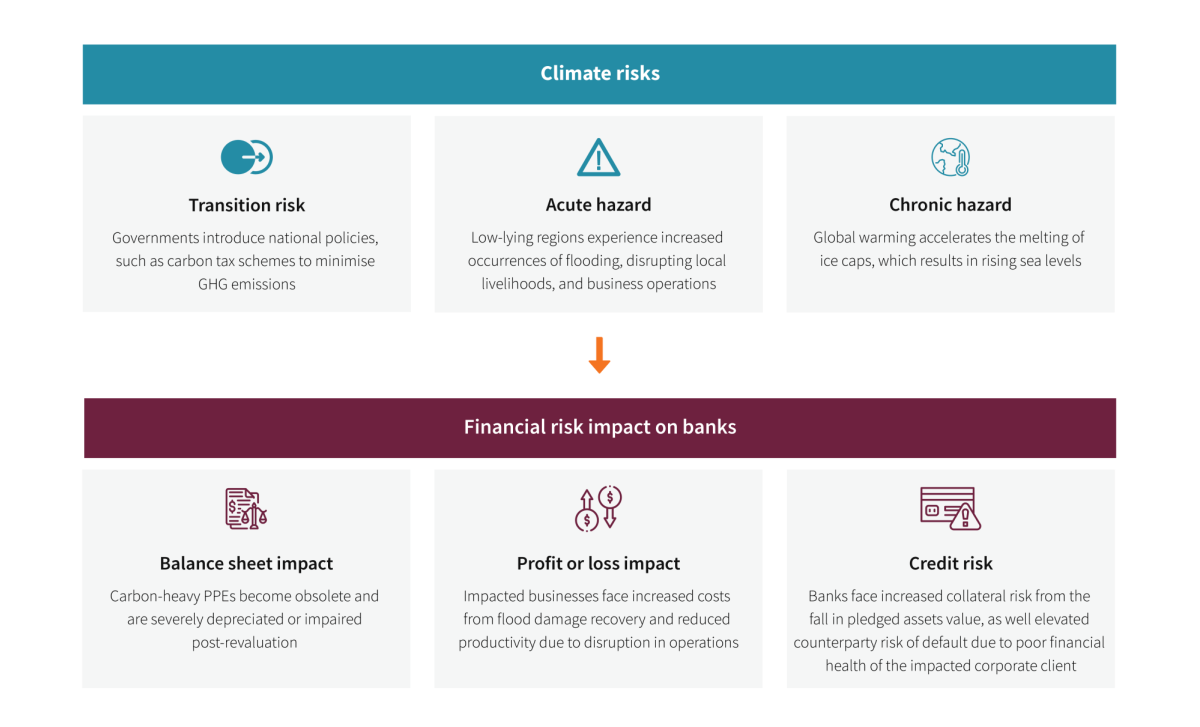In this article, we examine how climate risk impact banks’ credit risk exposure and provide a detailed understanding of how climate risks bring about credit risks, broken down into three key components – net residual risk, counterparty risk, and concentration risk.
Given the evolution of climate change, it is imperative for banks to perform an impact analysis on the manifestation of climate-related financial risks on their credit portfolio, so that sufficient capital reserves can be allocated to protect them from unexpected credit losses.
Generally, climate risks can be translated into credit risks through a three-step approach:

The effects of climate change vary across geographical locations and economic sectors, with some being more vulnerable to physical and transition risks than others. Several sectors, such as traditional oil and gas companies, are expected to experience significant disruption, while others, such as renewable energy, carbon capture, and adaptation technologies are likely to benefit.

Moreover, while mortgage portfolios in coastal areas may be exposed to the physical impact of climate change through rising sea levels and flooding, businesses in the agricultural industry may be heavily impacted by severe droughts and heat waves.
Global warming (chronic hazard) leads to erratic weather patterns and increases the magnitude and frequency of wildfires (acute hazard), which then influences governmental and non-governmental organisations to implement policies to mitigate the further increase in global temperatures (transition risk).
Under the revised mitigating policies, carbon-sensitive sectors, such as traditional oil and gas, aviation, shipping, and manufacturing, will be more prone to state penalties (e.g., carbon taxes or monetary fines), in cases where their Greenhouse Gas (GHG) emissions exceed certain thresholds. This not only results in higher costs of operations, but carbon-intensive firms are also likely to have their fixed assets impaired alongside the development of greener machinery and equipment that cause lesser damage to the environment.
Figure 3 provides examples of how climate risk hazards result in financial risk impact on banks.

For a more detailed understanding of how climate risks bring about credit risks, we have further broken-down credit risk into three primary components in Figure 4. As described in the Basel framework, there are net residual risk, counterparty risk, and concentration risk.

Net residual risk
Residual risk can remain after counterparty risk is offset with collateral, guarantees, or credit derivatives. This residual risk may be larger than expected if climate risk is a substantial contributing element of counterparty risk or credit risk management instruments.
In mortgage portfolios, for instance, coastal or rural homes are highly susceptible to damage caused by extreme weather conditions, such as torrential floods and typhoons, leading to direct write-offs of house collateral and potential mortgage default. Insurance companies may exclude coverage on climate-related damage and casualties in the future, as the location, timing, and magnitude of natural disasters become increasingly uncertain, leading to a heightened residual collateral risk for banks.
Mortgage loan amounts and tenures should, therefore, not be assessed and determined solely based on factors, such as income and financial commitments, commonly coined as the Total Debt Servicing Ratio. Instead, physical and transitional risk considerations should be incorporated in the haircut methodology to account for the impact of climate changes on the house condition and volatility of housing prices respectively.
Counterparty credit risk
As the world transitions into a low-carbon economy, firms operating in carbon-intensive industries, such as oil and gas, agriculture, and automotive may lose their competitiveness and be displaced by greener firms. These firms are likely subjected to higher carbon taxes on emissions or pushed to invest in technology that helps to reduce emissions and adapt to stricter environmental standards.1
The shift may also cause institutional clients to recognise large asset impairment amounts on their balance sheets, as their properties, plants, and equipment become obsolete. As the debt ratio of these institutional clients increases, banks will need to create additional Tier 1 capital buffers to manage the riskier lending activity.
Concentration risk
Concentration risk stems from having large credit exposures to counterparties in the same economic sector or geographic region, as well as those whose financial performance is dependent on the same activity or commodity. The effects of climate change vary substantially due to differences in locations and economic environments of entities, sectors, and economies.
Banks may underestimate their expected losses from credit positions held by firms from industries with substantial exposure to physical climate risks or from lending activities in places prone to natural hazards. For instance, a large majority of computer and electronic manufacturing companies operate in facilities that are set up in flood-prone Asian countries, exposing themselves to material damage, loss of machinery, and a temporary shutdown of operations.2 These outcomes impact the financial solvency of the firms and indirectly downplays their repayment ability.
Apart from considering the direct climate risk exposure on a firm’s core business activity, banks should also examine the operational, supply chain, and market risk factors of upstream and downstream activities to obtain a holistic view of its front-to-back climate risk exposure and a more accurate concentration risk estimate.
Our next article discusses how banks can enhance climate risk integration into credit risk frameworks. Check our next article to learn more.
How Synpulse can help
As climate risks pervade banks’ credit and investment portfolios, as well as day-to-day operations, it is crucial for banks to start incorporating climate risk factors in their risk management systems and processes. At Synpulse, we have both the subject matter expertise and end-to-end project delivery capabilities to develop bespoke solutions that best address individual clients’ needs.
For further information or a non-binding initial consultation, contact us.

